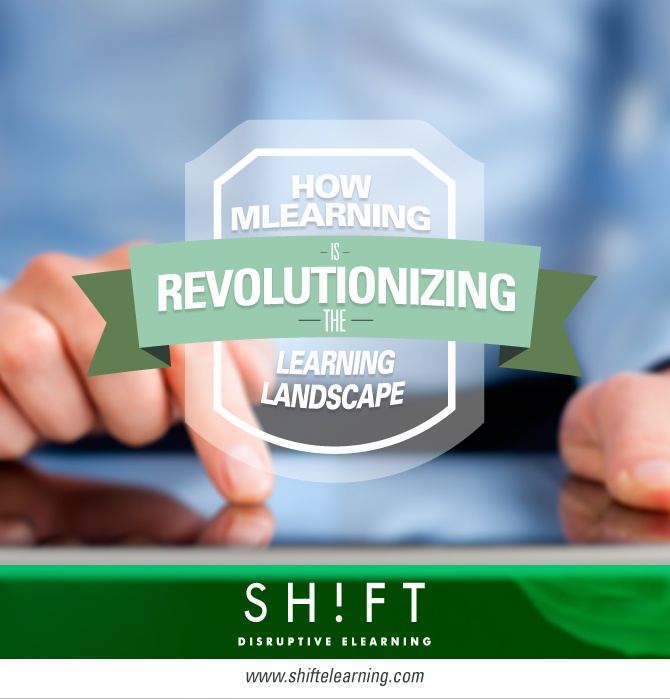Just the other day, it seems like I held a huge Nokia phone in my hand, telling my friends how amazing it was to be able to play Snake, message my friends, and call anyone in the world.
How things have changed. Just a few years on, the whole world is in our pocket, access to anything and everything, on demand, just as Tesla predicted.
By 2018, more than fifty percent of users will use a tablet or smartphone first for all online activities [1]. Also, its predicted that by this time there will be more than one billion users of wireless Internet. The field of education and corporate training has a responsibility to stay on the cutting edge of these changes in technology.
So far, the evidence suggests that we’re moving forward. 85% of organizations now identify just how important mobile is to learning, and are either implementing or planning to implement a mobile training strategy.[2]
Clearly, mLearning is changing the game. So now we’re going to look at a few ways that mobile is already transforming the world of corporate learning.

1) We’re Learning Anytime, Anywhere
Classroom learning was inflexible. eLearning was more flexible. Now, mLearning takes it to the next level. No longer are you bound by the presence of a teacher, a personal computer, and time availability.
There’s no need to travel to or from your learning environment, and no need to reserve time in your schedule: just a few minutes will do. This means that spontaneous, on-the-go learning is much more of a possibility.
This brings us the opportunity for a ‘kaizen’ approach to learning. Continuous, spontaneous, and flexible training that features not as a time-consuming chore, but an ad-hoc activity that becomes a part of your daily routine.
Check out this article: Eton Institute Promotes Spontaneous Learning Through Wearable Technology
2) Learning is Getting More Personal
One of the defining features of the ‘mobile learning revolution’ is personalization. Mobile technologies are giving workers the ability to choose the right tools for the right tasks, at the moments that works best for them. For us L&D professionals, this means we have more opportunities for including different applications and media that support more personalized learning, appealing to different learning preferences and needs. One learner may prefer Podcasts while another may prefer reading or watching a video, and another an interactive game or role-play scenario. This is the wonder of mobile devices: allowing workers to choose their own learning paths.
Machine learning is part of this. Soon, it’s entirely possible that your mobile device will be able to understand, plan, and tailor your learning to your individual needs and skills. That’s right, you heard it here first.
Mobile Learning is flexible and personal. You can move away from the linear structure of a conventional eLearning course, deconstruct the learning, and allow learners to access content in a non-linear way according to their needs and the level of mastery they have attained. This creates personalized learning experiences that make a training program more effective.
3) We Own Our Own Learning
Mobile devices allow people to feel that they ‘own’ their device, their applications, and consequently, the digital learning tools they keep on their device. The mobile device is a perfect encapsulation of the digital ‘you’, and learning comes into that. This is why the bring-your-own-device (BYOD) trend is continuing to pick up speed in many different organizations.
BYOD has been described as “the most radical change to economics and culture of client completing in business in decades”. While security is a key concern, as is observation of devices and device management, BYOD means that it’s easier to bring a sense of ownership, and so increased uptake, of mobile learning technologies.
Again, we see a merging between the personal and the professional. That brings us onto the next point.
4) A Dissolving Work-Learning Divide
mLearning doesn’t just mean that you learn more often and in a wider variety of places. It means that learning can happen when it needs to happen. It can provide performance support and quick, on-the-go learning.
Just like finding information (i.e. using Wikipedia, Google) is more spontaneous and ‘as-and-when’ in nature, learning on mobile platforms can follow this approach. Point-of-access mobile Wikis, databases, or video libraries can provide learning opportunities at the time of need.
Just as Clark Quinn recognizes, we need to look at broader approaches to mLearning and training. You can read more about this ‘learn and work’ philosophy here.
5) Learning is Now One-handed
We don’t need to just passively read any more. Learning used to be abstract, and in a way, more passive. Mobile technology provide multi-sensory experiences that leads us to use our brains, eyes, ears, and hands.
What does this mean? This means that touch technologies are pivotal to the mLearning revolution, and thumb-use preference shows that we generally learn one-handed, engaging our brains, eyes, and ears, and one of our hands. [3]
User behavior shows that this is a major trend in mLearning, and one-handed design is set to transform the corporate training world.
Changing Tides, Rolling Stones
Corporate training is being changed by the mLearning revolution. To remain competitive in an increasingly mobile learning landscape means that you have to learn about current mobile learning solutions and the new options that are coming out almost daily. It takes real dedication and commitment to stay abreast of the multiple new possibilities around eLearning and mLearning. And that’s where we come in - we’ll be here, documenting the industry’s shifting landscape through 2016 and beyond.
Additional recommended reads:
- The Mobile Learning Landscape 2015
- Mobile Technologies and Social Learning
- The convergence of mobile and social learning
REFERENCES:
1.Gartner Says By 2018, More Than 50 Percent of Users Will Use a Tablet or Smartphone First for All Online Activities. Dec 8, 2014. http://www.gartner.com/newsroom/id/2939217
2. CEO perspectives on people: leadership, recruitment and skills. Skillsoft.
3. Hoober, Steven. How Do Users Really Hold Mobile Devices? UX Matters. Published: February 18, 2013
Other references consulted:
Renner, Jim. Five Calls to Make When Developing a Mobile Learning Strategy. Skillsoft 2014.
Clancy, Martin. Designing for Touch: Thumb and Finger Sized Design. MobieForge 2013.








